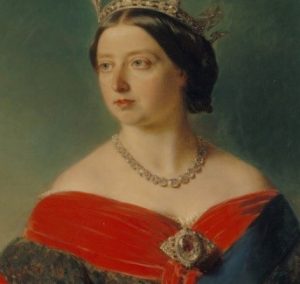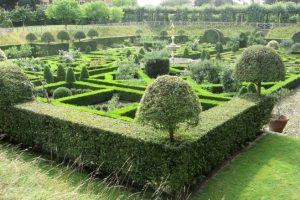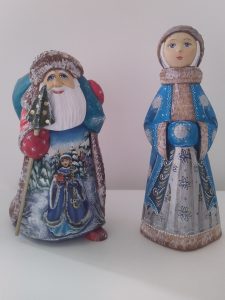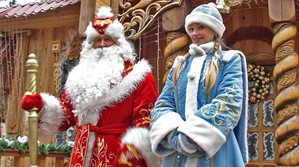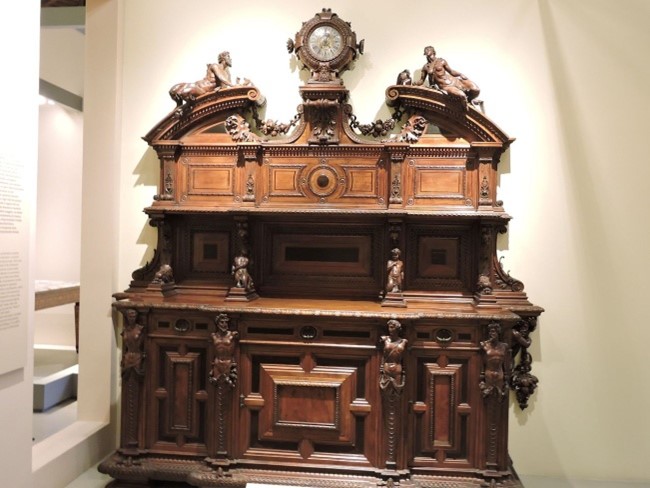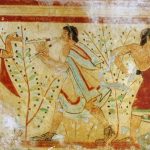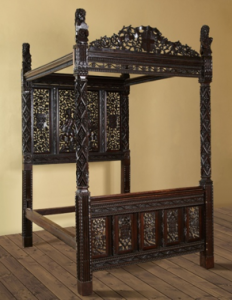Previous Lectures Sept. 2021 – June 2022
Previous Lectures Sept. 2022 – June 2023
Previous Lectures Sep 2023 – June 2024
June – Hogarth: Caricaturist or Character Painter
Vivien Heffernan
Vivien Heffernan’s captivating talk about Hogarth showed how he lampooned 18th century society in some of his most famous works but also illustrated his humanity with his incredibly beautiful and sensitive portraits.
His famous series of paintings entitled “Marriage a la Mode “shows the tragic results of an ill fated marriage which was entered into for money and social status. Vivien explored the hidden meanings in the paintings such as in the first image called “The Marriage Settlement”; the alderman can be seen holding the contract that will give the earl enough money to pay for his house to be finished. This house can be seen in the window and the carriage is too big for the arch and there are mistakes in the building work, shadowing the mistakes the people are making in the picture! The dogs and the engaged couple are looking away from each other so there is so much that is wrong in this picture that the viewer will expect the couple to have an unhappy union. The original purpose of this series of paintings was for a group of engravings as Hogarth was an engraver and he composed the pictures so that they could be read from left to right once they had been printed from the copper plate.
Hogarth loved curves and in his painting of “The Painter and His Pug” of 1745, the artist’s palette has “line of beauty and grace” written on it showing a curve. He paints curves even in gardens as well as when painting people. He used warm and rich colours with red featuring in many of his works, particularly his portraits such as in his portrait of Captain Thomas Coram, a personal friend of Hogarth and a philanthropist. It is a tender portrait. The line of beauty can be seen on his collar and cuffs. Through the use of heavy, smooth, loose brush strokes he portrays leather, skin and cotton.
Hogarth himself had an eventful life and was even imprisoned when on a trip to Calais to draw its fortifications; he was incarcerated overnight as he was suspected of being a spy!
May – Murder and Modernism: Walter Richard Sickert and The Camden Town Group
Nicola Moorby
The online lecture about the Camden Town Group of artists led by Walter Sickert gave a fascinating insight into the formation of this group and the subjects and styles of their paintings.
After settling in Britain in 1868 when he was eight, Sickert visited Paris in 1883 and met Edward Degas who greatly influenced his style as he produced paintings in the Impressionist mode. Sickert felt that paintings should show us “the magic and poetry from everyday life”. London was a crowded, bustling city which summed up the best and worst in people. He felt that British art was in a rut and in 1910 organised an exhibition in London which included works by the Impressionists. The public were unprepared for this style of painting and it was labelled as a “bad joke”. They were used to paintings for the upper classes so in 1911 the Camden Town Group came into being. It was so called because Sickert lived in Mornington Crescent. He and a group of artists including Spencer Gore, Charles Gilman and Charles Ginner met weekly at 19, Fitzroy Street and the public could visit, have tea and buy art. The idea was that people would become used to Impressionist type paintings which should be accessible to all.
Sickert believed great modern art should reflect the lives of the working class such as his painting of Tilly Pullen, a flower seller. His skills are seen in his nude painting called “Mornington Crescent Nude” which is set in a dark and dingy bedroom, but he brings her body to life with his paint effects. Sickert tapped into the drama of 1907 when a lady had her throat cut in a bedroom in Camden Town as he painted a series of pictures called “The Camden Town Murder Series”. There is a naked girl in bed with a clothed man beside her. Sickert does not describe the image as there is no blood but the paintings still manage to be psychologically disturbing and even the brush strokes are slashing. The group disbanded in 1914 but Sickert has been described as one of our great modern painters who “took flint and got out of it drops of roses”.
April – Peggy Guggenheim
Alexandra Epps
Although she was born into a wealthy and privileged life, Peggy Guggenheim was a lonely and unhappy child as her father was often away from home and then was lost in the Titanic. She claimed that she never got over this so she “Searched for a father all of my life.” She had many affairs and two marriages.
Her Grand Tour of Europe allowed her to buy art and in Paris she mixed with Bohemian artists such as Andre Breton, Salvador Dali and Max Ernst whom she married. She was at a loss for an occupation and, after being persuaded by Samuel Beckett decided to start an art gallery, with the help of Duchamp who taught her about art and surrealism and introduced her to sculptures; “The instant I felt it I wanted to own it.” In 1943 in New York she opened The Art of this Century Gallery showcasing not only her own collection but the work of 31 women, including Frida Kahlo. The gallery was divided into four spaces: the Abstract Gallery, the Surrealist Gallery, the Kinetic Gallery and the Daylight Gallery. The Daylight Gallery was used for temporary exhibitions featuring the works of over one hundred artists such as Dali, Kandinsky and Miro. She bought art herself from her exhibitions and accumulated more art.
After the war she set up home in Venice where she felt she belonged and this palazzo, its gardens and her art collection were opened to the public. She introduced Surrealism and abstract Expressionism to Europe and her reputation as an art collector grew. Even her dogs sat under a Picasso and she incorporated art into her daily life. It became fashionable to visit her in Venice and she received guests such as Truman Capote and Randolph Churchill .Art was her liberation and her freedom. She commented “I am not an art collector, I am a museum.” Alexandra concluded that we do not have to like all art –we need to give it the benefit of the doubt.
March – 2 Lectures:
Fakes and Fortunes.
“All that Glisters…”
Sarah Cove
This month we had two online lectures by Sarah Cove. She detailed her voyage of discovery in developing technical chronology which assists with the dating of art works. When examining Flatford Mill she initially used techniques such as infra red reflectography, radiography and pigment analysis. In determining whether or not a painting is a genuine Constable she explored his techniques such as his early paintings which were on a weave canvas, with reddish brown colours over a white background. From 1810 he painted on a canvas primed with either water or oil in a range of colours including pink and brown. As his career progressed he used yellows as in Dedham Vale. Chrome yellow was a major pigment in his paintings during the latter part of his career.
Her fascinating story behind the identification of Yarmouth Jetty involved her finding a portrait underneath which was of his two sisters. Sarah declared the painting to be an original Constable. She declared a miniature, thought to be a lost Constable, a fake as it was painted in tube paint which was not available during his lifetime so she valued it at £10!
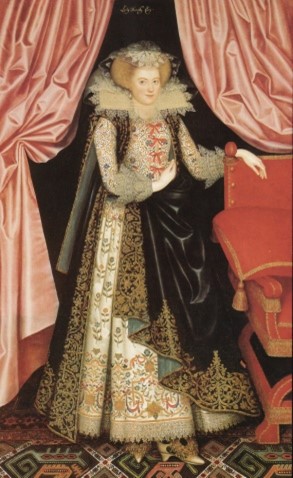
Miniatures featured in her second lecture which explored the influence and techniques of Jacobean court painter William Larkin whose methods originate in miniature painting, medieval manuscript illumination and Northern Europe painting traditions. In stark contrast to Constable, his stunning portraits of members of the court of King James 1 have details of jewellery, lace and embroidery, carpets and tapestries. She contrasted his painting of the third Earl of Dorset before and after she had conserved it and it is now in Kenwood House. Her enhanced slide of a dazzling shoe on the Fourth Earl of Dorset revealed a rosette with gold and silver spangles which had been woven together with gold and silver threads. Larkin worked on panel and created an under drawing. He developed a method of layering brown, orange and yellow to depict gold with dark grey, light grey and white for silver. She concluded by showing us large portraits of wealthy members of society and the aristocracy which were illuminated with evening candles thus creating a glittering effect.
February – Additional bonus lecture
The Koh-I-Noor Diamond
Georgina Bexon
The first was about the Koh-I-Noor diamond and Georgina took us on a fascinating journey from the time it was mined, with eight faces and a sharp point which resembled a mountain of light. It was 1,109 carats uncut. Although it is presently owned by the Queen, other countries such as India, Pakistan and Afghanistan claim it is theirs and it became known as the cursed stone as it attracted violence. It has always been in the crown of a monarch’s consort.
One of the earliest Indian exports was diamonds. Diamonds adorned Hindu mini-goddesses. They were part of life and culture and there were rules on how and when to use them. Colourful images of the stone were shown in various settings such as in the head of a peacock in The Peacock Throne. A diamond was believed to have magical or spiritual powers. Kings were murdered for the diamond. We were taken through the bloodthirsty times of the Mughals when one of the ways power was shown was through the display of jewels and they became part of the propaganda of the Mughal Empire.
The diamond was brought to England by the Governor General of India who wanted to impress Queen Victoria. It was recut and made into a brooch for Queen Victoria. Later it was put into Queen Mary’s Crown and later transferred to the Queen Mother’s Crown. Diamonds continue to be very desirable in the United Kingdom today.
February – Lucy Hughes-Hallett on the Gardens of Restoration England
Our second lecture also demonstrated how much the United Kingdom was influenced by fashions abroad in that it explored the gardens of Restoration England through stunning images depicting these gardens in wall hangings, Dutch and Flemish paintings and plans. During the Renaissance, beauty depended on symmetry; following nature when an animal has two eyes, two nostrils and a single wide mouth. Thus, the gardens they built had a central fountain with symmetry either side and above in terms of orange trees, hedges and statues. These ideas were brought by Royal landowners returning from exile in France and Holland. Each garden was enclosed by a wall and access was gained through an archway to a fountain. It was seen as a refuge, sealed off from the outside world such as in the gardens of Hatfield House. Colour was brought into these spaces by the ladies with their beautifully embroidered dresses. The embroidery displayed various aspects of nature and the Renaissance gardens became places where these dresses were worn and people sat together, socialised and had fun.
January – Angelica Kaufmann: An Artist in 18th Century England
By Leslie Primo
Swiss born, Angelica Kaufman was initially taught by her father and we were shown a stunning self portrait, completed in 1753 when she was only 13, depicting her as a young girl carrying a music sheet. Music and art were her two passions and a later painting of” The Artist Hesitating Between Arts and Music” shows her looking in two different directions; one towards music and the other towards a high mountain on top of which is a classical building. The building was a reference to the attitudes of the day when classical painters were considered to be of greater value in England than portrait painters.
Despite travelling to Italy and brilliantly copying the styles of Titian and Rembrandt and becoming a member of the all male Florence Academy of Design as she was so talented, she never achieved the status in England that a man would have done. She mixed with and painted great intellectuals of the time such as Van Goethe, Sir Joshua Reynolds and David Garrick and enjoyed celebrity status. She was a founder member of The Royal Academy but was missed out of the official painting of the time as she was a woman! She was depicted only as a painting on the wall!
By Angelica Kauffman-public
With a broken marriage and numerous supposed affairs Angelica’s reputation suffered and her paintings were not given their due recognition. Despite becoming a very much sought after portrait painter of the famous and the rich in England she was generally compared unfavourably with male classical painters. She returned to Italy, married Antonio Zucchi and made a fortune from Grand Tourers who saw portraits painted by her abroad as signs of wealth and success! Her house became an essential place to visit as” it breathed art.”
Her state funeral in Rome in 1807 had a procession equal in length to Michelangelo’s thus
illustrating how highly she was regarded there. Leslie’s lecture certainly revived her reputation here as a great artist who should be celebr
December – Grandfather Frost and the Old New Year: Russian Christmas
By Rosamund Bartlett
For our ninth online lecture, Stradfas was treated to a magnificent seasonal lecture about the different ways in which Russian people have celebrated Christmas.
As there is so much frost in Russia there was a belief that Moroz, a powerful, frosty figure, was the god of winter and cold ice who had to be respected otherwise he would cover people in ice. Lots of tales were told in the dark winter days which became part of the Russian Folk Tales. One of these told of a young girl who had been abandoned in the forest by a wicked stepmother and Moroz found the girl. She was so nice to him that he rewarded her with beauty and thus began the legend which eventually resulted in Moroz becoming part of the equivalent of the Russian Father Christmas. Children were frightened of him so a snow maiden was enlisted to help him! Ostrovsky wrote about snow maidens and we were played some of the music Rimsky Korsakov wrote about them.
St. Nicholas is the patron saint of Russia and is noted for his generosity but he is a saint and God’s deputy, so he is too important in the Russian Orthodox church to become a Father Christmas figure. However, after the reversal of the abolition of Christmas under Communism in 1937 a Father Christmas emerged in Russia who was a combination of Moroz, St. Nicholas and the uncle figure of Lenin.
It wasn’t until 1917 that Russia adhered to the Gregorian calendar, except for members of the Orthodox Church, so Christmas was on January 7 and New Year was the week after. There were no carol services and life went on as normal throughout that week but there was fasting and the Russians adhered to long religious ceremonies. There were prayers to dead relatives at the icon in the corner of a room in the house and when fasting ended there was a dinner of 12 different symbolic foods such as poppy seed for peace.
Pagan traditions saw a belief in dead spirits and evil spirits roaming the earth at Christmas and fortune tellers came to the fore at this time of year when there was a transition from the winter solstice from 25 December to January 5. Rosamund showed a beautiful slide of a painting by Bryullov of Svetlana Fortune Telling showing candles and a girl in front of a mirror. It was believed that a future husband would appear in the mirror. People dressed up and sang folk carols outside a church.
Western traditions have influenced Russians at Christmas. In 1817 the future Tsar Nicholas married Princess Frederike from Germany and she introduced the Christmas tree which Germans believed were linked to mortality and Dostoevsky wrote stories about these trees. The Nutcracker was based on a German story and Rosamund showed us a picture of the first time it was performed in Russia. Christmas cards were not allowed until 1894 when they were imported from England. The Russians printed over them using calligraphy wishing everyone a Happy Christmas and New Year so they became works of art in themselves.
In Russia today, Grandfather Frost and his snow maiden can be dialled to visit any household but he is a little different from our Father Christmas as he has a longer beard, felt boots and is transported in a troika pulled by horses, wishing us a Merry Christmas and a Happy New Year in Russian so
“S novym godom” to everyone!
November – Undressing antiques
By Mark Hill
The humorous, colourful and enthusiastic Mark Hill of The Antiques Road Show aimed to convince us that antiques are not for the elite. No matter what our budget or current décor, we can all afford to buy an antique which would fit in with our existing furniture.
Fashion goes in 30 year cycles and so now more people are wanting antiques as they pull away from the kind of mass produced modern furniture which became popular from the 1970’s. A slide of a 19th century rococo piece on which were standing two classical urns, against a light coloured wall on which were hanging modern pictures, worked together beautifully because of shape and colour. The curved shape from the furniture was reflected in the urns and the pictures. The gold colour in the pictures was seen in the urns and on the handles of the furniture. Mark proved that antique furniture can be affordable as he gave an example of an exquisite Regency sofa which sold for £500 at an auction and had stood the test of time, and compared it to a modern sofa from a department store for £1,200 which may not turn out to be so durable. He argued that in such cases could you afford not to buy antiques?
Antiques are more interesting, in Mark Hill’s view, than modern mass produced furniture, as they can tell stories such as the scratches which he found on a William IV breakfast table which turned out to be from sewing machine clamps which the table had been used for. The ball and claw feet of a piece show how much time and skill has gone into producing it, so claw feet showing sinews would be on furniture which would be more expensive than a plain ball and claw leg. If hairs are carved as well then that would be an even more expensive article to buy.
An article may change in value according to fashion. We were shown a blue and white meat platter which would have originally been on display in an oak dresser but nowadays kitchens are slim-line, sleek and are of light, clean colours, so there is not the demand for such a piece of furniture. Consequently, the price of the plate plummeted and can now be more easily afforded. Advances in technology have also affected the value of antiques, as a beautiful bureau we were shown was £2,000 twenty years ago, but now, because a computer would not fit onto it, the value is £200! So again, an antique has become more accessible to more people.
Mark’s advice to us if we want to venture into the world of antiques is to create a mood board of your colours and know what it is you are looking for. Read books, trust dealers by getting to know them. Handle the object and take a tape measure when you go to buy! Most of all enjoy your antique!
The image is attributed to Harvinder Chandigarh
October – The Art of Dance
By Jennifer Toynbee-Holmes
Stradfas was online for the seventh time in October with a lecture by former BBC producer and director Jennifer Toynbee-Holmes.
Dance is one of the oldest forms of art and has been used in rituals, celebrations and healings. We were shown examples of 9000 year old cave paintings with men, women and children festival dancing. In Egyptian times, men and women danced but not together. Dance was performed by girls for religious reasons but mostly dance has been used as a form of celebration.
Ballet became part of Court entertainment in 1533, when it celebrated marriage and power. By the first half of the 17th century Court Ballet was common and masque balls were performed which were full of satire. Large, brocaded costumes were worn to a Grand Ball in Bilbao, and the steps of the dance had to be simple promenades and hops because of the size of the dresses. In 1661 the Royal Academy of Dance was founded in Paris and ballet developed as a form of dance to be performed onstage. By 1789 emotions were displayed in ballets such as The Wayward Daughter and a video clip showed Frederick Ashton’s 2004 interpretation with lightweight costumes which moved with the body, and the dancers were on tiptoe.
September – The Marriage Bed Of Henry VII And Elizabeth of York
By Dr. Jonathan Foyle
Our sixth online Stradfas lecture in September took us on a detective hunt when Dr. Jonathan Foyle shared his quest to identify the origin of a broken bed!
The bed was found in the Honeymoon Suite of The Redland House Hotel and when the hotel was sold, pieces of the bed went up for auction and they were bought by Ian Coulson. He gave Jonathan an oak lion to examine which he believed came from the bed. The bed itself had rich Germanic carving but entire panels were missing as well as the top rails. It was finely carved but decrepit. There was a royal fleur- de -Lys and an English coat of arms on either side of nude figures who were surrounded by fruits such as acorns.The couple are enveloped in a banderol and their feet are masked by a lion and a dragon. Various flowers are also shown. However, Jonathan was not convinced it was Victorian so he set out to search for other parts of it.
Intensive research, involving Singapore, a study in Huddersfield and a shop in Chelsea revealed the nude couple to be Henry VII and Elizabeth of York. Amongst many other pointers, the carved roses seemed to confirm this, as the red rose had been used by Henry VI as a Christian symbol with five red petals as the blood of Christ and the whole symbol being one of a Christ-like leader. Edward IV used the white rose as a symbol of the purity of the virgin and Elizabeth of York was his descendant so this is a symbol proving it is her as one of the figures. The acorn represents fertility. The lion which started the whole investigation was found to be one of three evil beasts which this mystical marriage would crush. Jonathan found many other clues as to the origin of the bed including his discovery that it conformed to the design of the state bed which originally stood in The Painted Chamber of Westminster Palace. It now resides, beautifully restored, at Hever castle.

